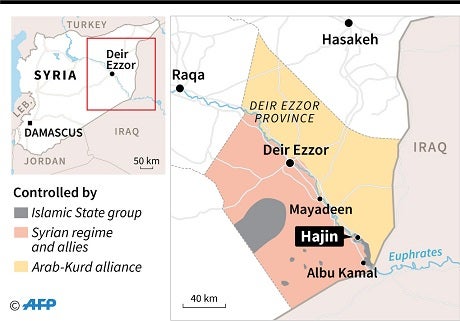The Islamic State group has fiercely defended its last holdout in eastern Syria against a more than two-month military offensive by a Kurdish-Arab alliance backed by a US-led coalition.
After the Syrian Democratic Forces alliance successfully expelled the jihadists from other parts of war-torn Syria, why is this latest battle in the far east taking so long?
Who is inside the holdout?
Hundreds of fighters are believed to be inside the pocket, which lies in the oil-rich province of Deir Ezzor near the Iraqi border.
The US-led coalition has estimated some 2,000 fighters to be present in the holdout, which includes the towns of Hajin, Sousa and Al-Shaafa.
According to SDF commanders on the front line, a great number of those combatants are likely to be non-Syrians.
The SDF has said it believes "major leaders" of IS are hiding inside the pocket, where most front line commanders are Iraqis.
Nicholas Heras, an analyst at the Center for a New American Security, says "a mini army of several hundred fighters... has been assembled by IS there, including some of its best snipers."
The Syrian Observatory for Human Rights, a Britain-based war monitor, says IS family members are also inside the embattled jihadist holdout.
Why the tough IS fightback?
IS overran large parts of Syria and neighbouring Iraq in 2014, declaring a "caliphate" across territories it controlled.
But various offensives in both countries have routed the jihadists from most of that land, crushing their dreams of statehood.
In Syria, the extremists saw their dominion shrink to an eastern pocket around Hajin, although they also have a presence in the country's vast Badia desert.
On September 10, the SDF launched an offensive supported by coalition strikes to expel IS from the Hajin patch on the Euphrates River's eastern bank.
Syria analyst Tore Hamming said that, after years of defeats, battle-hardened IS fighters in that last redoubt were likely determined to fight to the bitter end.
"They know that they will either be killed by an air strike, or captured and put into prison," he said.
"IS knows the area extremely well, having been operating there for more than five years now and arguably has some level of local support."

What are the complications?
Analysts say the battle to expel IS from the Hajin pocket will be tough.
In recent weeks, the jihadists have taken advantage of low visibility in bad weather to launch vicious counter-attacks.
Under cover of sand storms, and using suicide bombers, they last month managed to reverse all SDF advances inside the pocket.
Most recently, IS fighters have burst out of the fog, killing 92 US-backed fighters since Friday, according to the Observatory.
More than 450 SDF fighters have been killed since the start of their offensive on September 10, the monitor says, while more than 730 jihadists have also died.
SDF spokesman Kino Gabriel said key obstacles to defeating IS included bad weather, and IS using "all types of weapons, car bombs, and civilians as human shields".
On the opposing side, the SDF is "using all its capacities including special forces, heavy weapons and all military units that are present", he said.
Heras said the remaining battle in Deir Ezzor would be "the most treacherous of the entire campaign" against IS.
"The SDF is relying on local Arab tribal fighters to wage the war against IS there, and these local fighters do not want to take casualties," the analyst said.
"IS has turned this area into a deathtrap, and the SDF's (local) fighters are well aware of this."
All this makes "the fight there slow-moving and tortuous, which is putting pressure on the SDF to hurry things up," he said.
The coalition remains optimistic.
"At this point in the operation, there are not enough IS (fighters) to make any significant or lasting gains," coalition deputy commanding general Christopher Ghika said on Sunday.
The coalition says IS has lost most of its financial resources, and is instead relying on improvised explosive devices and cave complexes "to retain their shrinking influence".




Comments
Rudaw moderates all comments submitted on our website. We welcome comments which are relevant to the article and encourage further discussion about the issues that matter to you. We also welcome constructive criticism about Rudaw.
To be approved for publication, however, your comments must meet our community guidelines.
We will not tolerate the following: profanity, threats, personal attacks, vulgarity, abuse (such as sexism, racism, homophobia or xenophobia), or commercial or personal promotion.
Comments that do not meet our guidelines will be rejected. Comments are not edited – they are either approved or rejected.
Post a comment